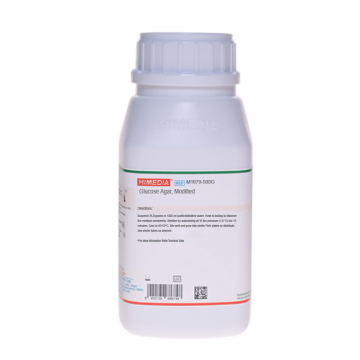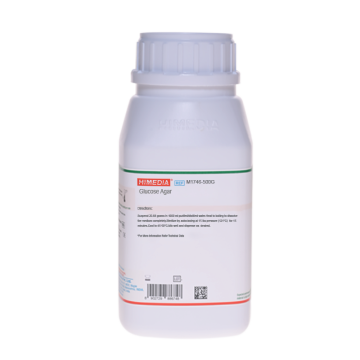 Your enquiry has been submitted
Your enquiry has been submitted
Glucose Agar
Intended Use
For determining the fermentation reaction of presumptive Enterobacteriaecae.
Composition**
| Ingredients | Gms / Litre |
|---|---|
| Tryptone | 10.000 |
| Yeast extract | 1.500 |
| Dextrose (Glucose) | 10.000 |
| Sodium chloride | 5.000 |
| Bromocresol purple | 0.015 |
| Agar | 15.000 |
Final pH ( at 25°C): 7.0±0.2
**Formula adjusted, standardized to suit performance parameters
Directions
Suspend 41.52 grams in 1000 ml purified / distilled water. Heat to boiling to dissolve the medium completely. Sterilize by autoclaving at 15 lbs pressure (121°C) for 15 minutes. Cool to 45-50°C. Mix well and pour into sterile Petri plates.
Principle And Interpretation
Enterobacteriaceae are widely distributed and found in soil, water, vegetation and the intestinal tract of animals. Examination of foods, ingredients and raw materials, for the presence of marker groups such as coliforms or total Enterobacteriaceae, is one of the most common tests in food microbiology laboratory, because of the relative speed and ease with which the tests can be accomplished. Enterobacteriaceae are gram-negative chemoautotrophs that possess both respiratory and fermentative metabolism. Glucose Agar medium is used in the presumptive identification of Enterobacteriaceae based on the fermentation observed in the medium (1). This medium is also recommended by ISO (2,3) as a solid medium for the confirmation of Enterobacteriaceae.
The medium contains tryptone and yeast extract, which provides nitrogenous source and other essential growth factors. Sodium chloride maintains the osmotic balance of the medium. Glucose in the medium provides the energy source and when fermented produces acid. The production of acid is indicated by yellow colour, as the indicator bromocresol purple turns yellow under acidic conditions.
Type of specimen
Food and dairy samples, Water samples
Specimen Collection and Handling
For food and dairy samples, follow appropriate techniques for sample collection and processing as per guidelines (4,5,6). For water samples, follow appropriate techniques for sample collection, processing as per guidelines and local standards (7). After use, contaminated materials must be sterilized by autoclaving before discarding.
Warning and Precautions
Read the label before opening the container. Wear protective gloves/protective clothing/eye protection/ face protection. Follow good microbiological lab practices while handling specimens and culture. Standard precautions as per established guidelines should be followed while handling specimens. Safety guidelines may be referred in individual safety data sheets.
Limitations
- This medium is general purpose medium and may not support the growth of fastidious organisms.
- Further biochemical and serological identification needs to carried out for confirmation.
Performance and Evaluation
Performance of the medium is expected when used as per the direction on the label within the expiry period when stored at recommended temperature.
Quality Control
Appearance: Cream to yellow homogeneous free flowing powder
Gelling: Firm, comparable with 1.5% Agar gel
Colour and Clarity of prepared medium: Purple coloured, clear to slightly opalescent gel forms in Petri plates
Reaction: Reaction of 4.15% w/v aqueous solution at 25°C. pH : 7.0±0.2
pH: 6.80-7.20
Cultural Response
Cultural characteristics observed after an incubation at 35-37°C for 18-24 hours.
| Organism | Inoculum (CFU) | Growth | Recovery | Colour of Medium |
|---|---|---|---|---|
| #Klebsiella aerogenes ATCC 13048 (00175*) | 50-100 | luxuriant | >=70% | yellow |
| Escherichia coli ATCC 25922 (00013*) | 50-100 | luxuriant | >=70% | yellow |
| Pseudomonas aeruginosa ATCC 27853 (00025*) | 50-100 | luxuriant | >=70% | colourless |
Key : * Corresponding WDCM numbers and # - Formerly known as Enterobacter aerogenes
Storage and Shelf Life
Store between 10-30°C in a tightly closed container and the prepared medium at 20-30°C. Use before expiry date on the label. On opening, product should be properly stored dry, after tightly capping the bottle inorder to prevent lump formation due to the hygroscopic nature of the product. Improper storage of the product may lead to lump formation. Store in dry ventilated area protected from extremes of temperature and sources of ignition. Seal the container tightly after use. Product performance is best if used within stated expiry period.
Disposal
User must ensure safe disposal by autoclaving and/or incineration of used or unusable preparations of this product. Follow established laboratory procedures in disposing of infectious materials and material that comes into contact with sample must be decontaminated and disposed of in accordance with current laboratory techniques (8,9).
Reference
- Corry J. E. L., Curtis G. D. W. and Baird R. M., Culture Media For Food Microbiology, Vol. 34, Progress in Industrial Microbiology, 1995, Elsevier, Amsterdam.
- ISO 4702 Standard, 1993, Microbiology General Guidance For The Enumeration Of Enterobacteriaceae Without Resuscitation
- ISO 8523 Standard, 1991, Microbiology General Guidance For The Detection of Enterobacteriaceae With Pre-enrichment.
- American Public Health Association, Standard Methods for the Examination of Dairy Products, 1978, 14th Ed., Washington D.C.
- Salfinger Y., and Tortorello M.L. Fifth (Ed.), 2015, Compendium of Methods for the Microbiological Examination of Foods, 5th Ed., American Public Health Association, Washington, D.C.
- Wehr H. M. and Frank J. H., 2004, Standard Methods for the Microbiological Examination of Dairy Products, 17th Ed., APHA Inc., Washington, D.C.
- Greenberg A. E., Clesceri L. S. and Eaton A. D., (Eds.), 2005, Standard Methods for the Examination of Water and Wastewater, 21st ed., APHA, Washington, D.C.
- Isenberg, H.D. Clinical Microbiology Procedures Handbook 2nd Edition.
- Jorgensen, J.H., Pfaller, M.A., Carroll, K.C., Funke, G., Landry, M.L., Richter, S.S and Warnock., D.W. (2015) Manual of Clinical Microbiology, 11th Edition. Vol. 1.
| Product Name | Glucose Agar |
|---|---|
| SKU | M1589 |
| Product Type | Regular |
| Physical Form | Powder |
| Origin | Animal |
| Packaging type | HDPE |
| References | 1. Corry J. E. L., Curtis G. D. W. and Baird R. M., Culture Media For Food Microbiology, Vol. 34, Progress in IndustrialMicrobiology, 1995, Elsevier, Amsterdam. |
| Customized Product Available | No |







